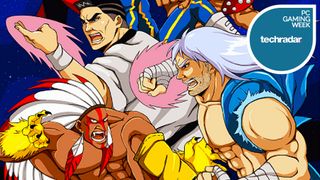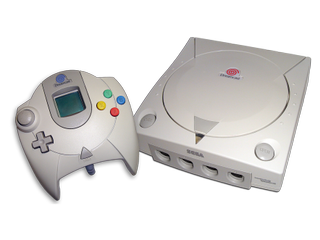
This article was provided to TechRadar for PC Gaming Week by Edge magazine. Follow Edge on Twitter here. Click here for Edge subscription offers.
There are many names to describe subcultures, in time subsumed into the public consciousness and dispensed as labels. But there's no label that quite sticks to Falco Girgis and his ilk. What they do is far too under the radar for that.
Girgis is the creator and lead engine architect of Dreamcast game Elysian Shadows. The first thing that makes his work so unusual is that he began it in 2004, three years after Sega discontinued its platform and quit console-hardware production for good. But what started off as homebrew has evolved.
A decade later, Elysian Shadows finally nears release, having been successfully funded on Kickstarter in August this year. It's now a split-run production made by a full team, and is coming to more modern systems such as PC, Android, Ouya and iOS as well as Dreamcast in the winter of 2015.
Elysian Shadows today is a 2D RPG and a paean to the 16-bit era, fusing together elements of classic Final Fantasy and Secret Of Mana, but one with modern physics, audio and lighting. As for what got it started, Girgis recalls that he wanted to make a 2D roleplaying game in the spirit of Chrono Trigger, only with the absolute best that Dreamcast could offer.
He had a lot to learn. "I really grew up in the Dreamcast scene," he recalls, "helping to unlock the secrets of Dreamcast's hardware and learning to render sprites on the platform before I could even do the same on my PC." Girgis also taught himself C, then recruited his younger brother and best friend to help make his passion project.
Adventures In Game Development
The long journey to bring a new Dreamcast RPG to market has been documented in remarkable detail. "Soon after development began," Girgis says, "we began recording our late-night development sessions, so that we could use the footage as unlockable in-game content for players once they beat Elysian Shadows." In October 2007, Girgis and his team decided to put the videos on YouTube instead. They called it Adventures In Game Development.
Get daily insight, inspiration and deals in your inbox
Get the hottest deals available in your inbox plus news, reviews, opinion, analysis and more from the TechRadar team.
This video series gained a strong following outside the Dreamcast homebrew scene, eventually convincing Girgis and his evolving cast of team members to re-architect their Elysian Shadows engine to be multiplatform so as to reach a broader audience. The team's vision may have scaled up, but Girgis can't let Sega's console go. That version "has become a personal quest".
Elysian Shadows is intended to push the console, with a custom video driver incorporating features such as hardware bump mapping and dynamic lighting. "We really want to become something of a swan song for Sega's little white box," says Girgis. "[Elysian Shadows is meant to be] a long-standing tribute to the console that innovated so much – online gaming, visual memory cards, beautiful graphics – but wound up burning out and dying young."

Life in the old dog yet
Elysian Shadows might do even more to keep Sega's final console going. When we previously documented the hackers, dreamers and creators making commercial titles for obsolete consoles, in E164, it highlighted how many homebrew games for vintage hardware required either custom assemblers or were rehashes and updates of older ideas and base code.
That's still the case today, but with Elysian Shadows' preorder and Kickstarter sales being Dreamcast dominated, Girgis has decided to release the team's custom-built development tools alongside Elysian Shadows. "We think releasing these tools and allowing you to basically create your own Dreamcast games with them will be something huge that the Dreamcast community doesn't currently have," he says.
Girgis and the Elysian Shadows production team might be at the forefront of tool development for a discontinued system, but they are far from alone in keeping it on life support, nor are they the first to straddle releases across both deceased systems and modern platforms.
Last Hope
In 2007, NG:DEV. TEAM released sidescrolling shooter Last Hope on the console, German developer Duranik put out shoot 'em up Sturmwind last year to a modest reception, and Netherlands studio Senile Team's Rush Rush Rally Racing came to Dreamcast in 2009, before finding a second life on Nintendo hardware via WiiWare in 2012.
For the time being, however, other would-be Dreamcast developers lacking the wherewithal to build their own tools face a conundrum: they can dabble in modding the likes of Doom and Senile Team's freeware Streets Of Rage tribute Beats Of Rage, which respectively allow for easy creation of knockoff firstperson shooters and sidescrolling beat 'em ups, or they can dive deep into code with the KallistiOS development library.
With the Elysian Shadows toolkit, Girgis suggests, it will be possible to create all manner of 2D and pseudo-3D games without necessarily doing a lick of coding – or at least with nothing more than Lua scripting – which could make Dreamcast a hobby development wonderland.
The effect of these tools on the market is impossible to predict, but right now retro homebrew titles find a surprisingly dedicated audience, explains René Hellwig, an artist and developer who was involved in founding both NG:DEV.TEAM and HuCast. (The latter is the developer behind Dux and its sequels). While his fanbase may be largely Dreamcast and Neo Geo die-hards eager to amass complete collections, "they also seem to care about playing our games and not just buying them only for [collecting]".
Dreamcast limits
Like Girgis, the teams have had to compromise on visual fidelity to keep games on a console as old as Dreamcast. "There are limits in RAM for graphics," Hellwig notes, "which means that we sometimes have to cut graphics out of the game to make them fit the system's graphics RAM."
Still, Hellwig manages to crank a little more out of the hardware each time around. His signature series, Dux, for instance, has gone through multiple releases, progressively polishing what came before. "I felt it was about time to fulfil my promise to deliver a more well-balanced and polished Dux game," Hellwig explains. And so Dux 1.0 gave way to Dux 1.1 and then 1.5, and there's also a Redux: Dark Matters remake, all available to buy in professionally printed packaging.
Homebrew development isn't limited to Dreamcast, either. WaterMelon made its name on the scene in 2010 with Mega Drive and Sega CD RPG Pier Solar And The Great Architects, renowned for being the first original Mega Drive title published in the US since 1998. Spurred by Pier Solar's success, first on the dead console and then more recently on Kickstarter (where it raised $231,370 for a HD port to Dreamcast as well as several modern systems), the team has professionalised and grown to the point where it can support other developers working on old tech.
Indeed, the Elysian Shadows team announced in May this year that WaterMelon would be helping to produce physical copies of its game as well as to fund some of the development. "What [WaterMelon] did with Pier Solar on Genesis a few years back is very similar to what we set out to do with Elysian Shadows on Dreamcast," Girgis explains. "So you can imagine how excited we all were when we got an email from Tulio [Adriano], WaterMelon's president, offering us a publishing deal."
No longer a small-time pursuit for lone hobbyists, this scene has become a veritable cottage industry, although it can't sustain full-time incomes for many. Instead, these hackers and dreamers do what they do out of passion. They can't let go of the systems they loved when they were younger, or of the idea that their beloved old hardware has more potential – more life in it – than the play-and-discard cycle that the mainstream has settled into will allow.
They also exhibit an enduring nostalgia for old forms of game, as the many homages, rehashes and remakes of the classics illustrate. And many of them, together with their audiences, feel left behind by the game industry's pursuit of ever bigger productions, of increasing complexity and realism.
